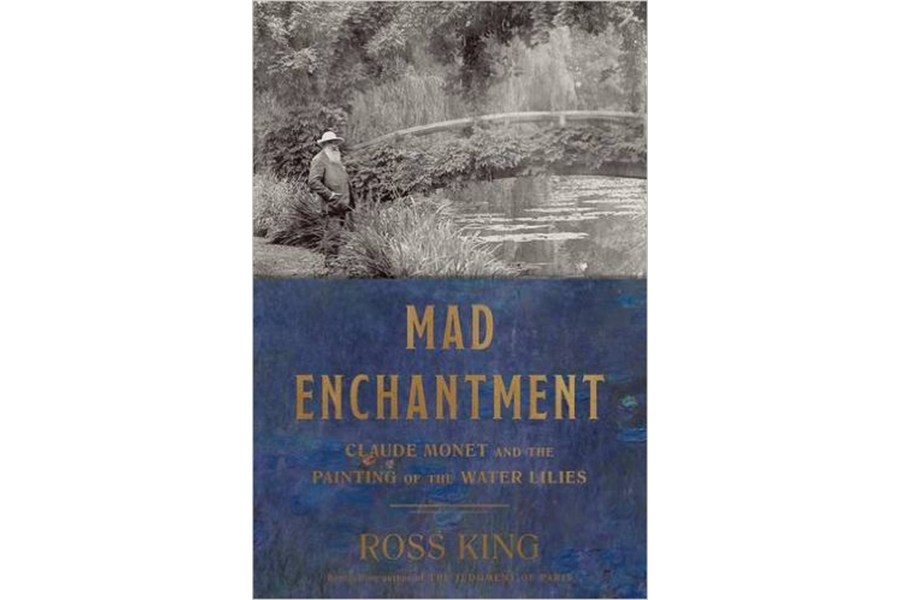'Mad Enchantment' is a compelling portrait of Monet and his chef d'œuvre
Loading...
First came the house. In 1883, Claude Monet rented a rambling house with gardens in the picturesque little Normandy town of Giverny, and he and his large family moved in. By 1890 Monet was able to buy the house, and he straightaway set to work enlarging and sculpting the grounds, outfitting a barn as a studio, and experimenting with ways to map his art onto this new personal landscape. For the next 30 years, until his death in 1926, that garden in Giverny was the cynosure of Monet's creative life, and for 20 of those 30 years, it was the focus of his art, the subject of one of the most remarkable artistic projects any painter has ever attempted.
The tempestuous beginnings and at times precarious continuance of that project is the subject of Mad Enchantment: Claude Monet and the Painting of the Water Lilies, the new book by Ross King, whose earlier books "Brunelleschi's Dome" and "Leonardo and the Last Supper" likewise put human faces on the historical narrative of artistic triumphs.
Each of these three subjects presented its own challenges. The construction of Brunelleschi's dome in 15th-century Florence was a boringly quotidian process with a stunning outcome. The creation of Leonardo's Last Supper is scantily documented and over before you know it. And the same is true for those decades at Giverny: As in any bustling household examined over decades, far more happens in the kitchen than in the studio.
King's story is helped immeasurably by Monet's volcanic temper, which kept both kitchen and studio bubbling most of the time. Monet had broken into the art world 20 years earlier, battled the closed minds of the artistic establishment, and by the time he settled in Giverny was only just beginning to enjoy the renown – and the money – of being France's greatest living painter, an “old man mad about painting,” a man one biographer described as being caught in a lifelong “dream of form and color.”
That dream often tormented Monet; King's account is full of tense moments in which the painter gave way to epic fits of rage in which he sometimes turned his anger against his own canvases. He described himself as “at war with nature and time,” and "Mad Enchantment" captures that war with page-turning intensity.
And that intensity is considerably heightened by the most unexpected figure of them all: firebrand French politician Georges Clemenceau, the “Tiger” of the public square and, according to King, “the only person in France who could manage Monet.” As unlikely as the pairing seems, Clemenceau was a close and dogged friend to Monet, and he sweeps into a book about the painter and very nearly steals it for himself (the effect inadvertently reminds readers that it's been a scandalous 50 years since there was a full-dress biography of the man in English). The wife of a British statesman said of Clemenceau that he was “swifter in thought, wittier in talk, more unexpected in what he said, than anyone I ever knew.... No one was ever such fun as he was.”
Clemenceau wasn't all fun, naturally, and his presence in King's story foreshadows World War I that would encroach on Giverny and threaten to tear apart Monet's world. In the summer of 1914, Clemenceau saw that storm approaching and took every opportunity to warn his countrymen about Germany: “Her fury for the leadership of Europe decrees for her a policy of extermination against France. Therefore, prepare, prepare, prepare.”
It was Clemenceau who inimitably pictured Monet “picking a fight with the sun,” and the heart of King's book dramatizes that fight superbly. Monet, King writes, “concentrated not only on the objects themselves but also, critically, on the atmosphere that surrounded them, the erratically shifting phantoms of light and color that he called the enveloppe.” King paraphrases an earlier biographer writing emphatically that Monet's paintings “captured nature's mix of the ephemeral and the eternal, its magnitude and its minutiae, its glittering appearances and its dizzying fathomless depths.” Monet plumbed those depths at Giverny by studying the play of light and weather on small patches of well-tended landscape and then painting those patches over time. It was, when you think about it, an uncanny idea – the kind of inspiration the world relies on its geniuses to have.
Monet died on December 5, 1926, at Giverny, with his friend Clemenceau at his bedside, and in his final chapter, King does a quick and effective job of outlining the artist's steadily growing posthumous fame. The book touches on the astronomical auction prices Monet's paintings have fetched in recent years, but the heart of the artist's renown has always been visceral rather than venal. The exclamation King quotes from one critic in 1922 could easily apply to the general experience of encountering these stunning masterpieces from Giverny: “To create impalpable matter from canvas and paste … to trap the sun, to focus and diffuse its light. Quel miracle!”








